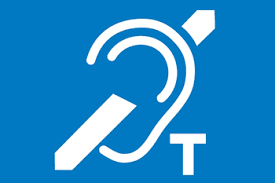A hearing loop is a type of assistive listening system that can be found around the world in a variety of public venues. Also known as an audio induction loop, the hearing loop system transmits a magnetic, wireless signal that is picked up by the telecoil (T-coil) within the hearing aid when it’s set to the T setting. This technology directly broadcasts sound to hearing aids, eliminating background noise and enhancing clarity.
The system contains an audio source, an amplifier, and a loop cable that encircles a designated area, bringing sound directly to the hearing aid wearer. It’s one of the best ways to get accessible audio in places like airports, auditoriums, and churches since it can broadcast directly to a variety of hearing aids.
Who Can Benefit from Using a Hearing Loop?
Hearing loops are beneficial for individuals with hearing loss who use hearing aids or cochlear implants equipped with a T-coil. It’s especially useful in environments where background noise or distance from the sound source makes listening challenging.
Other benefits include:
- No need to use a receiver/headset
- Sound goes directly into the hearing aid
- It is inconspicuous
- Cost effective
- Any number of users can use the system
- Can cover any size of space.
Where are Hearing Loops Commonly Installed?
They can be found in a variety of locations. In reception areas, meeting rooms, classrooms, theaters, cinemas and concourses, on board public transportation or integrated into help points, intercoms or museum exhibits.
The following is the internationally recognized hearing loop sign that indicates where a hearing loop system is available.

How Can Someone with a Hearing Aid Access and Use a Hearing Loop System?
To access a hearing loop, the user must switch their hearing aid to the T-coil setting. This enables the hearing aid to pick up the magnetic signal from the loop system, delivering the sound directly into the user’s ears. This direct connection allows for a significant reduction in background noise and clearer sound reception.
Benefits and Limitations of Hearing Loops
Hearing loops offer many advantages, such as reducing background noise, not requiring the user to wear additional receivers or headsets, and providing sound directly into the hearing aid, tailored to the user’s specific needs. However, users must have hearing aids compatible with T-coils, and the system’s effectiveness is confined to the looped area. Other technologies like FM and infrared systems may offer more flexibility in certain scenarios, but usually require additional equipment like receivers and might not integrate as seamlessly with hearing aids.
Need Help? Have a Question? Contact Us Today!
At the Regional Hearing & Balance Center, your health and well-being are our top priority. If you have more questions or concerns about the hearing loops and how they interact with your hearing aids, don’t hesitate to reach out to our expert team. Call us at 208-497-3596 or click here to book a complimentary hearing assessment.


Recent Comments